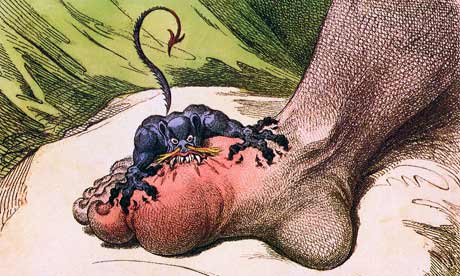
You may not think you have much in common with Henry VIII, one of the most famous figures in history to suffer from gout, but research shows that the condition is on the increase in England. Emergency admissions doubled between 1999-2009 (a rise from 1,875 to 3,496) and up to one in 70 people will have a less dramatic attack.
Gout can affect any joint in the arm or leg but typically the joint at the base of the big toe, which swells, reddens and is incredibly tender. The affected joint may have white lumps (called tophi) of urate crystals under the skin. Gout is caused by a build-up of uric acid in the blood and tissues, usually because the kidneys can't get rid of enough uric acid into the urine. Uric acid is a broken-down product from the food we eat. Indulging in the wrong kinds of food can make levels rise, saturating the tissues and crystallising in the joints. Gout usually gets better in a couple of weeks (sooner with treatment) but can return and damage the joint. So, should you watch your diet to reduce your risk of gout?
The solution
Gout typically affects men between the ages of 40 and 60. Women are protected until after the menopause. If your parents have gout, you have a one in four chance of getting it. To reduce your risk of an attack, rheumatology guidelines suggest eating less uric-acid-producing, purine-rich food. This includes: red meat, offal, seafood, mussels, crab, anchovies, herring, mackerel, sardines and caviar, yeast-containing foods and drinks (Marmite and beer) and game (rabbit, venison, and pheasant). Even some vegetables contain purines – mushrooms, asparagus, spinach, lentils and cauliflower – but there is evidence they are less likely to cause gout than diets with meat or shellfish.
To avoid gout you should ideally look for a proportion of protein sources other than meat, such as cheese and nuts that are low in purines. Beer can trigger an attack (gout is over twice as common in men drinking only two bottles of beer a day) but so can drinking any type of alcohol over the recommended healthy limits (21 units for men and 14 for women per week).
Being overweight increases the risk of gout. Gradual dieting reduces uric acid levels but rapidly losing weight can increase levels and trigger an attack. Avoid the Atkins diet (high protein, low carbohydrates): it's purine-tastic. Drinks containing lots of fructose syrup are also gout-inducing.
Some foods may protect against gout. Cherries lower uric acid levels: a recent study of 633 patients found that those eating the fruit for two days were 35% less likely to have an attack than those who didn't eat any.
If you do show any symptoms, you should see your doctor. Gout can be treated but it can also be associated with other medical conditions that need looking at, such as high blood pressure, diabetes and obesity.

